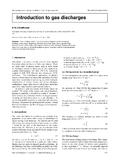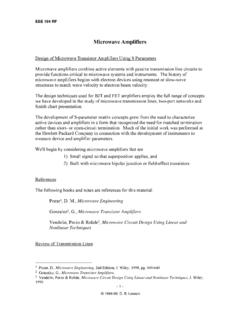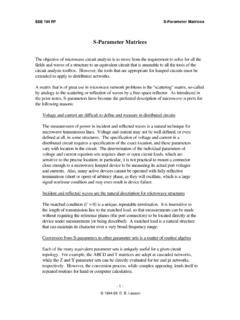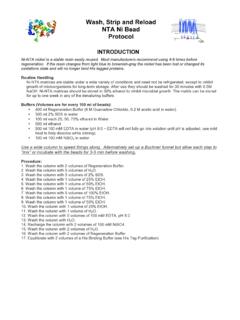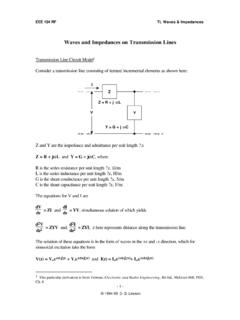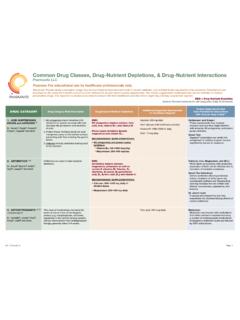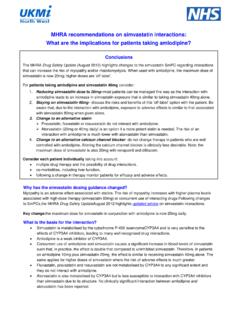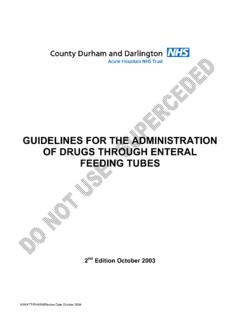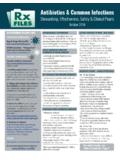Transcription of Statins: mechanism of action and effects
1 Vol 5, No 4, 2001 pp. 378-387. Review statins : mechanism of action and effects Camelia Stancu, Anca Sima *. "Nicolae Simionescu" Institute of Cellular Biology and Pathology, Bucharest, Romania Received: November 12, 2001; Accepted: December 5, 2001. Introduction effects on Classification of statins - cholesterol esterification and - How they are obtained its accumulation in macrophages - Liver metabolism - endothelial cell function - Physico-chemical properties - inflammatory process - Specific activity - proliferation, migration and Mechanisms for the action of statins apoptosis of arterial smooth muscle cells - Mechanisms involving lipids - stability of the atherosclerotic plaque - Mechanisms involving intracellular - platelets activation signaling pathways - coagulation process Beneficial effects of statins Adverse effects of statins therapy Conclusions Abstract The beneficial effects of statins are the result of their capacity to reduce cholesterol biosyntesis, mainly in the liver, where they are selectively distributed.
2 As well as to the modulation of lipid metabolism, derived from their effect of inhibition upon HMG-CoA reductase. statins have antiatherosclerotic effects , that positively correlate with the percent decrease in LDL cholesterol. In addition, they can exert antiatherosclerotic effects independently of their hypolipidemic action . Because the mevalonate metabolism generates a series of isoprenoids vital for different cellular functions, from cholesterol synthesis to the control of cell growth and differentiation, HMG-CoA reductase inhibition has beneficial pleiotropic effects .
3 Consequently, statins reduce significantly the incidence of coronary events, both in primary and secondary prevention, being the most efficient hypolipidemic compounds that have reduced the rate of mortality in coronary patients. Independent of their hypolipidemic properties, statins interfere with events involved in bone formation and impede tumor cell growth. Keywords: HMG CoA reductase cell signaling LDL oxidation atherosclerosis cancer . osteoporosis endothelial dysfunction macrophage smooth muscle cell *Correspondence to: Dr. Anca SIMA 8, B.
4 P. Hasdeu Street, Bucharest 79691, Romania. "Nicolae Simionescu" Institute of Tel.: (+401) ; Fax: (+401) Cellular Biology and Pathology E-mail: Vol 5, No 4, 2001. Introduction only for cholesterol, but also for many other non- steroidal isoprenoidic compounds, inhibition of this statins , inhibitors of 3-hydroxy-3-methylglutaryl- key enzyme may result in pleiotropic effects . They coenzyme A (HMG-CoA) reductase, have revolu- have been divided into two categories, involving: tionized the treatment of hypercholesterolemia. They directly lipids, or intracellular signaling pathways.
5 Are the most efficient agents for reducing plasma The first category includes: inhibition of cholesterol cholesterol, being also appreciated for their good to- biosynthesis, increased uptake and degradation of lerance. Angiographic studies have demonstrated low density lipoproteins (LDL), inhibition of the that these compounds reduce the progression and secretion of lipoproteins, inhibition of LDL. may induce the regression of atherosclerosis. These oxidation, and inhibition of the scavenger receptors effects were translated in significant cardiovascular expression [3].
6 statins modulate a series of processes morbidity and mortality reductions in many clinical leading to reduction of the accumulation of esterified trials (WOSCOPS, AFCAPS/TexCAPS, HS, CARE, cholesterol into macrophages, increase of endothelial LIPID, HPS) [1]. The beneficial effects of the HMG- NO synthetase, reduction of the inflammatory CoA reductase inhibitors are usually attributed to process, increased stability of the atherosclerotic their capacity to reduce the endogenous cholesterol plaques, restoration of platelets activity and of the synthesis, by competingly inhibiting the principal coagulation process [3].
7 Enzyme involved [2]. Since mevalonate, the product In addition, statins can inhibit tumor cells growth of HMG CoA reductase reaction, is the precursor not and enhance intracellular calcium mobilization. It Fig. 1 Chemical structure of the statins and HMG-CoA. 379. was observed that inhibitors of HMG-CoA reductase CYP 2C9 pathway, and pravastatin is metabolized induce a reduction of the formation of osteoclasts in differently [6]. The majority of the statins have a low rodents [3]. Human subjects treated with statins have circulation concentration: 12% for atorvastatin, 17%.
8 Shown a reduction in the number of bone fractures [4]. for pravastatin, 20-30 % for fluvastatin, 5% for The discovery of statins has led to an important simvastatin and lovastatin. Cerivastatin has a progress in the primary and secondary prevention circulation distribution of more than 60%. of coronary heart disease. Although angiographic modifications following statin therapy were mo- Physico-chemical properties dest, clinical benefits that accompanied the therapy have been significant. Numerous clinical studies Pravastatin is extremely hydrophilic, fluvastatin has have correlated the reduction of blood cholesterol intermediar characteristics, lovastatin, simvastatin, induced by these compounds with the reduction of atorvastatin and cerivastatin are hydrofobic [7].
9 The number of major coronary events, as well as general mortality in coronary patients [1]. Specific activity Atorvastatin, cerivastatin, fluvastatin and Classification of statins pravastatin are administered as active compounds (acid form). Lovastatin and simvastatin are There are a number of classification criteria for administered as inactive forms (lactone), which statins , including: 1) how they are obtained, 2) liver have to be enzymatically hydrolized to generate metabolism, 3) physico-chimical properties, 4) active forms [7]. specific activity.
10 How they are obtained Mechanisms for the action of statins Some of the statins are obtained after fungal Mechanisms involving lipids fermentation: lovastatin (Mevacor), pravastatin (Lipostat, Pravachol) and simvastatin (Zocor), others Dyslipidemia and hypercholesterolemia are by synthesis: fluvastatin (Lescol), atorvastatin controled by the liver. Hepatocytes take up from the (Sortis, Lipitor), and cerivastatin (Baycol, Lipobay). circulation ~ 50% of LDL cholesterol. An increase It must be stressed that on August 8, 2001, Bayer in the activity of LDL receptor in hepatocytes could AG voluntarily withdrew cerivastatin (Baycol, be an efficient method to decrease plasma LDL.)
